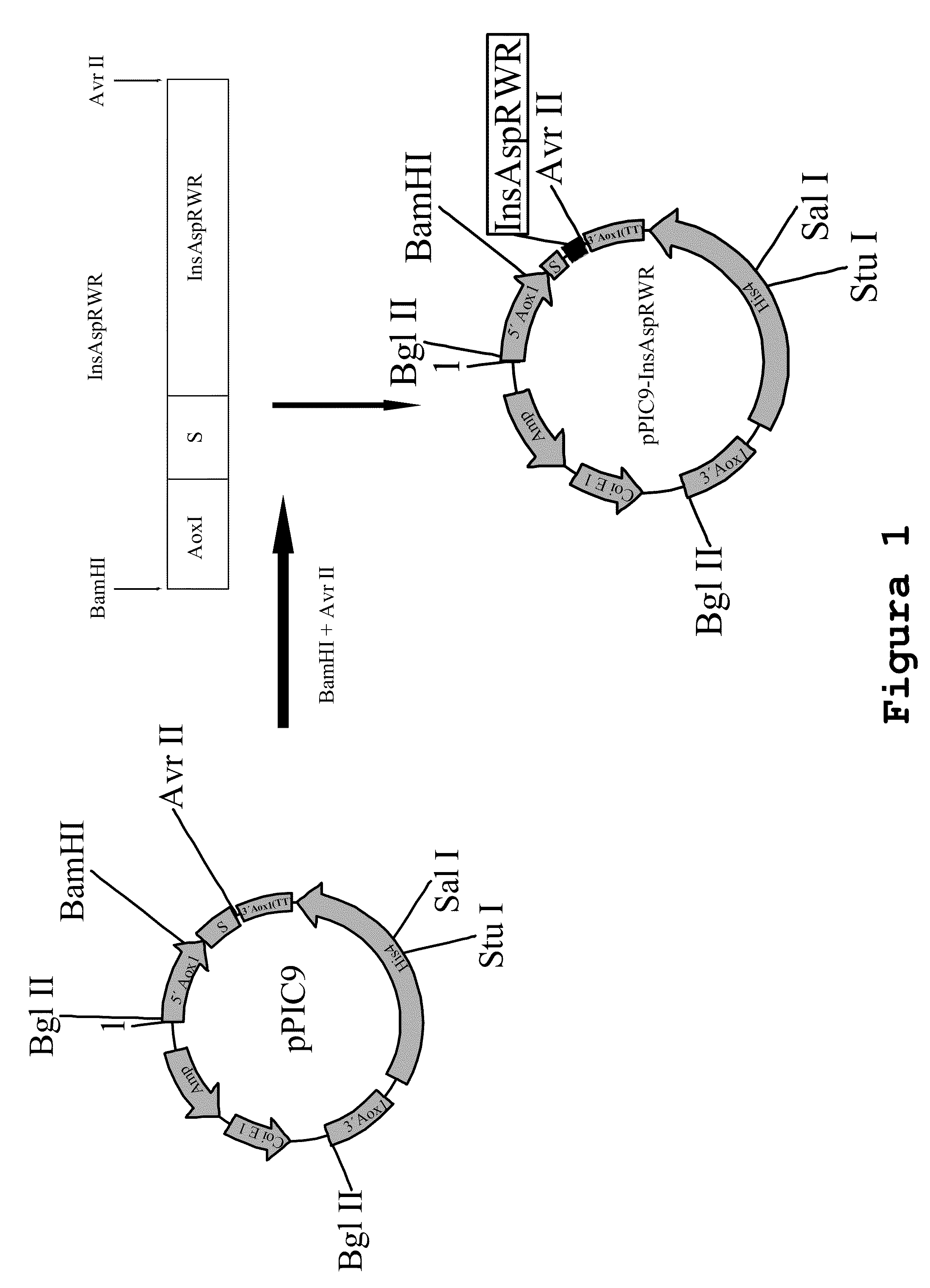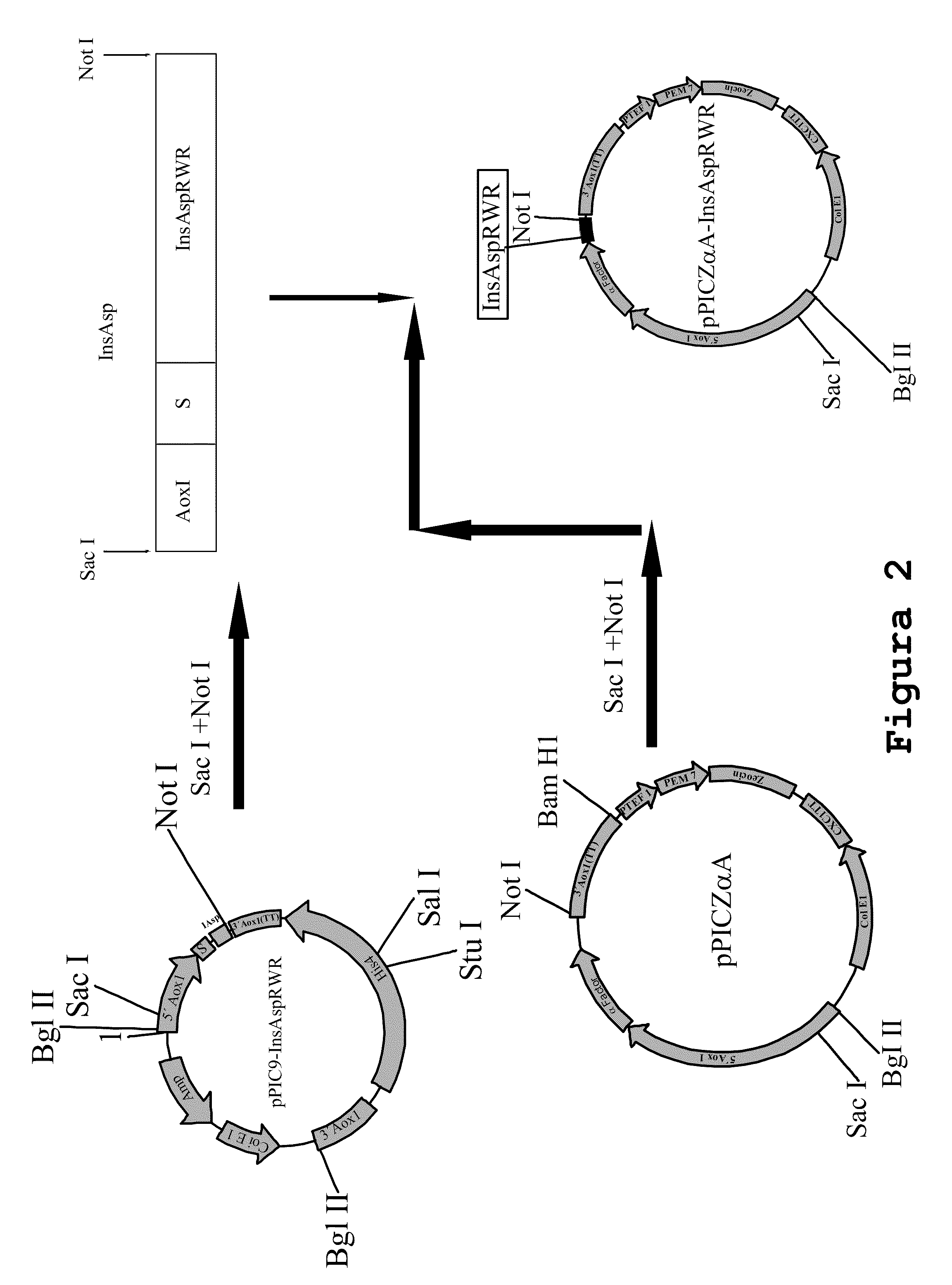Process for obtaining aspart insulin using a pichia pastoris yeast strain
- Summary
- Abstract
- Description
- Claims
- Application Information
AI Technical Summary
Benefits of technology
Problems solved by technology
Method used
Image
Examples
example 1
Construction of an aspart insulin Precursor from a miniC-insulin-type Precursor
[0129]This construction was performed using the miniC-insulin precursor sequence of formula B(1-30)-Lys-Arg-A(1-21) as a template, with Pichia codons, as described in SEQ ID No. 1, and making the following modifications:[0130]a) replacing the proline B28 amino acid precursor by an aspart residue;[0131]b) replacing dipeptide-Lys-Arg-, which links together insulin B and A chains, by tripeptide-Arg-Trp-Arg-, to obtain an aspart insulin precursor of formula B28Asp(1-30)-Arg-Trp-Arg-A(1-21).
[0132]The procedure involved three sequential PCR reactions.
[0133]In the first reaction, the pPIC9Ins vector, containing miniC-insulin with Pichia codons and with the miniC Lys Arg described in SEQ ID No. 1, was employed as a template. SEQ ID NO. 2, which hybridizes to the AOX1 promoter, and SEQ ID NO.3, homologous to a 3′ portion of the gene, were used as primers; in the latter sequence codons cca were replaced by gac enco...
example 2
Cloning of the InsAspRWR Gene into Vector pPICZαA
[0169]Insert InsAspRWR SEQ ID No6 was subcloned into the pPICZαA vector. Vector pPIC9InsAspRWR was digested with enzymes Sacl and Notl, the fragment containing the gene of interest was purified from gel using QIAEX II reagent (Promega) and was ligated to vector pPICZαA previously digested with the same restriction enzymes. The final construct was designated pPICZαAInsAspRWR, a scheme of which is shown in FIG. 2.
example 3
Selection and Isolation of Recombinant Yeasts
[0170]Transformations of the yeast Pichia pastoris, strain GS115, with vector pPIC9InsAspRWR digested with Bgl II favors recombination at the AOX I locus. Replacement of the structural gene, alcohol oxidase (AOX I), occurs with a frequency from about 15 to 35% among His+ transformants. His+ colonies from the transformation were selected according to the following protocol:
[0171]Each colony was taken up with a sterile tip and a mark or streak was made, first on a MM plate and then on a MD plate.
[0172]In order to distinguish both phenotypes GS115 / His+ Mut+ and GS115 / His+ Muts (Invitrogen) controls were included.
[0173]Plates were incubated at 30° C. for about 48-72 hours. By this method it was possible to distinguish Muts clones as those growing normally on MD plates, and no growth on MM plates.
[0174]Each of the Muts or Mutr clones selected by this method was purified and pure clones were isolated. Isolation was carried out by streaking each...
PUM
| Property | Measurement | Unit |
|---|---|---|
| Temperature | aaaaa | aaaaa |
| Fraction | aaaaa | aaaaa |
| Fraction | aaaaa | aaaaa |
Abstract
Description
Claims
Application Information
 Login to View More
Login to View More - R&D
- Intellectual Property
- Life Sciences
- Materials
- Tech Scout
- Unparalleled Data Quality
- Higher Quality Content
- 60% Fewer Hallucinations
Browse by: Latest US Patents, China's latest patents, Technical Efficacy Thesaurus, Application Domain, Technology Topic, Popular Technical Reports.
© 2025 PatSnap. All rights reserved.Legal|Privacy policy|Modern Slavery Act Transparency Statement|Sitemap|About US| Contact US: help@patsnap.com



